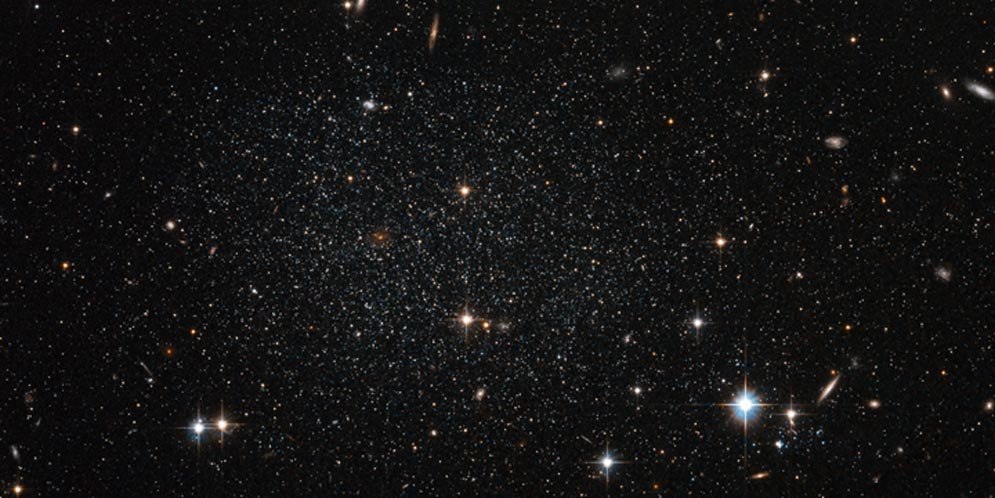
Peppers the Sky with Stars
Dwarf Galaxy
RA 10h 04m 03.9s Dec -27° 20' 01"
Antlia
4 million light years (1.3 Mpc)
2.0' × 1.5' arcmin
15.7
ESA/Hubble & NASA
February 27, 2012
Related Image: G9920
ABOUT THIS IMAGE:
The myriad faint stars that comprise the Antlia Dwarf galaxy are more than four million light-years from Earth, but this NASA/ESA Hubble Space Telescope image offers such clarity that they could be mistaken for much closer stars in our own Milky Way. This very faint and sparsely populated small galaxy was only discovered in 1997.
Although small, the Antlia Dwarf is a dynamic site featuring stars at many different stages of evolution, from young to old. The freshest stars are only found in the central regions where there is significant ongoing star formation. Older stars and globular clusters are found in the outer areas.
It is not entirely clear whether the Antlia Dwarf is a member our galactic neighborhood, called the Local Group. It probably lies just beyond the normally accepted outer limits of the group. Although it is fairly isolated, some believe it has interacted with other star groups. Evidence comes from galaxy NGC 3109, close to the Antlia Dwarf (but not visible in this image). Both galaxies feature rifts of stars moving at comparable velocities; a telltale sign that they were gravitationally linked at some point in the past.
This picture was created from observations in visible and infrared light taken with the Wide Field Channel of Hubble's Advanced Camera for Surveys. The field of view is approximately 3.2 by 1.5 arcminutes.
From Wikipedia:
The Antlia Dwarf is a dwarf spheroidal/irregular galaxy. It lies about 1.3 Mpc (4.3 Mly) from Earth in the constellation Antlia. It is the fourth and faintest member of the nearby Antlia Group of galaxies. The galaxy contains stars of all ages, contains significant amounts of gas, and has experienced recent star formation. The Antlia Dwarf is believed to be tidally interacting with the small barred spiral galaxy, NGC 3109
The Antlia Dwarf was first cataloged in 1985 by H. Corwin, Gérard de Vaucouleurs, and A. de Vaucouleurs. Later in 1985 and 1987 it was noted as a possible nearby dwarf galaxy by two groups of astronomers. It was finally confirmed as a dwarf galaxy in 1997 by Alan Whiting, Mike Irwin and George Hau during a survey of the northern sky. For the first time, they resolved it into stars and determined the distance to be 1.15 Mpc. In 1999 Antlia Dwarf was identified by Sidney van den Bergh as the fourth member of the Antlia Group: the group of galaxies closest to the Local Group.
The Antlia Dwarf is classified alternatively as a dwarf elliptical galaxy of type dE3.5, or either as a dwarf spheroidal galaxy (dSph) or as a transitional galaxy from spheroidal to irregular types (dSph/Irr). The last classification is due to a substantial star formation in this galaxy in the last 0.1 billion years.
Antlia Dwarf comprises two components: a core and an old halo. Its half-light radius is about 0.25 Kpc. The metallicity is very low, at about <[Fe/H]>=-1.6 to -1.9 meaning that Antlia Dwarf contains 40-80 times less heavy elements than the Sun. The galaxy has a well-defined and easily observed red giant branch, which makes measuring its distance relatively easy. The total luminosity of Antlia Dwarf is approximately 1 million times that of the Sun.
The stellar mass of Antlia Dwarf is estimated to be about 2-4×106 solar masses, while its total mass (within the visible radius) is approximately 4×107 solar masses. The galaxy contains stars of all ages but is dominated by old stars with the age of more than 10 billion year. There seems to have been a major episode of star formation in the Antlia Dwarf around 100 million years ago. However, the young stars are confined to the central core of the galaxy.
Antlia Dwarf is unusual among dwarf spheroidal galaxies in that it contains large amounts of neutral atomic hydrogen. However it does not have significant H II regions and does not actively form stars at the present moment.
The Antlia Dwarf is located about 4.3 million light-years away, in the constellation Antlia. Its distance from the barycenter of the Local Group is about 1.7 Mpc. At this distance, it is situated well outside the Local Group and is a member of a separate group of dwarf galaxies called Antlia Group. The Antlia Dwarf is separated from the small spiral/irregular galaxy NGC 3109 by only 1.18 degrees, which corresponds to a physical separation of 95,000 to 180,000 light-years.
The Antlia Dwarf and NGC 3109 may be actually physically bound if the distance between them is not very large. However their velocity relative to each other (43 km/s) makes it questionable whether they are in fact a bound system, especially if the distance between them is closer to the upper limit of 180 kpc. If they are gravitationally bound, their total mass may be as high as 78 billion solar masses.
Observations
have also demonstrated that NGC 3109 has a warp in its gaseous disk that
is traveling at the same velocity as the gas in the Antlia Dwarf, indicating
that the two galaxies had a close encounter about one billion years ago.